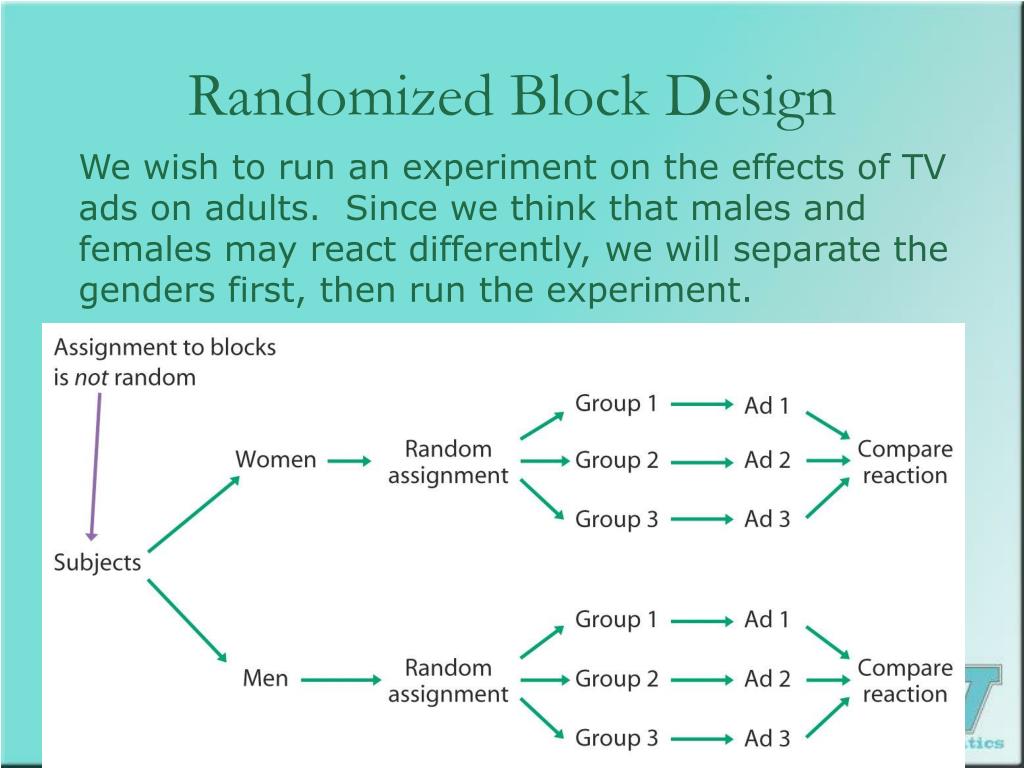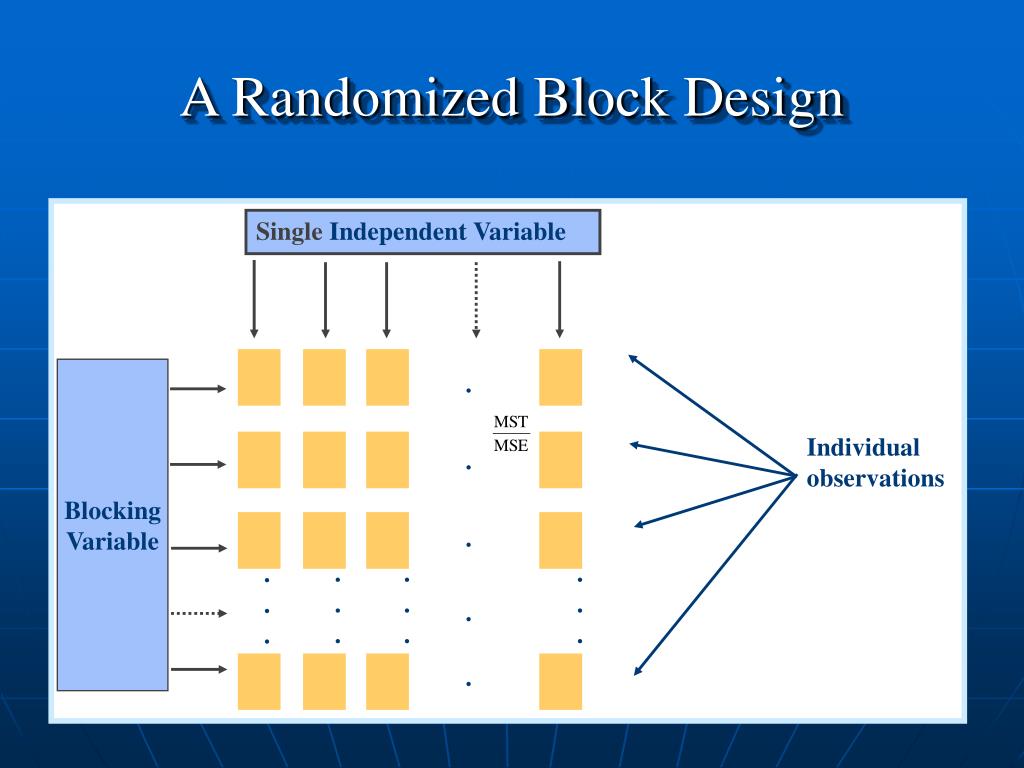Table Of Content

A resolvable 2-design is a BIBD whose blocks can be partitioned into sets (called parallel classes), each of which forms a partition of the point set of the BIBD. Designs are usually said (or assumed) to be incomplete, meaning that the collection of blocks is not all possible k-subsets, thus ruling out a trivial design. Since the first three columns contain some pairs more than once, let's try columns 1, 2, and now we need a third...how about the fourth column. If you look at all possible combinations in each row, each treatment pair occurs only one time.

ANOVA: Yield versus Batch, Pressure
The row and column and treatment all have the same parameters, the same effects that we had in the single Latin square. In a Latin square, the error is a combination of any interactions that might exist and experimental error. To conduct this experiment as a RCBD, we need to assign all 4 pressures at random to each of the 6 batches of resin.
Error
The simplest case is where you only have 2 treatments and you want to give each subject both treatments. Here as with all crossover designs we have to worry about carryover effects. Because of the restricted layout, one observation per treatment in each row and column, the model is orthogonal. When the data are complete this analysis from GLM is correct and equivalent to the results from the two-way command in Minitab. What if the missing data point were from a very high measuring block?
The ANOVA for Randomized Complete Block Design (RCBD)
A randomized block design is a type of experiment where participants who share certain characteristics are grouped together to form blocks, and then the treatment (or intervention) gets randomly assigned within each block. Using the example from the last section, we are conducting an experiment on the effect of cell phone use (yes vs. no) on driving ability. The independent variable is cell phone use and the dependent variable is driving ability.
Effects of γ-polyglutamic acid on grassland sandy soil properties and plant functional traits exposed to drought stress ... - Nature.com
Effects of γ-polyglutamic acid on grassland sandy soil properties and plant functional traits exposed to drought stress ....
Posted: Wed, 14 Feb 2024 08:00:00 GMT [source]
Therefore the Greek letter could serve the multiple purposes as the day effect or the order effect. The Greek letters each occur one time with each of the Latin letters. A Graeco-Latin square is orthogonal between rows, columns, Latin letters and Greek letters. As the treatments were assigned you should have noticed that the treatments have become confounded with the days.
In each block, for each treatment, we are going to observe a vector of variables. The final step in the blocking process is allocating your observations into different treatment groups. All you have to do is go through your blocks one by one and randomly assign observations from each block to treatment groups in a way such that each treatment group gets a similar number of observations from each block.
Choose your blocking factor(s)

An alternate way of summarizing the design trials would be to use a 4x3 matrix whose 4 rows are the levels of the treatment X1 and whose columns are the 3 levels of the blocking variable X2. The cells in the matrix have indices that match the X1, X2 combinations above. If we choose one of the RCB Design Structures, Temperature effects are completely randomized at the Run level. Recipe is nested within temperature and has a different error structure than temperature, because each dough appears within each run.
Now, say you have reason to believe that athletes tend to run 10% faster on turf fields than grass fields. When in doubt, decide on the number of blocks based on previous literature. Suppose engineers at a semiconductor manufacturing facility want to test whether different wafer implant material dosages have a significant effect on resistivity measurements after a diffusion process taking place in a furnace. They have four different dosages they want to try and enough experimental wafers from the same lot to run three wafers at each of the dosages.
Minitab’s General Linear Command handles random factors appropriately as long as you are careful to select which factors are fixed and which are random. My guess is that they all started the experiment at the same time - in this case, the first model would have been appropriate. Let's take a look at how this is implemented in Minitab using GLM.
In this example we wish to determine whether 4 different tips (the treatment factor) produce different (mean) hardness readings on a Rockwell hardness tester. The treatment factor is the design of the tip for the machine that determines the hardness of metal. Many industrial and human subjects experiments involve blocking, or when they do not, probably should in order to reduce the unexplained variation. Here are the main steps you need to take in order to implement blocking in your experimental design. First the individual observational units are split into blocks of observational units that have similar values for the key variables that you want to balance over.
A Latin Square design blocks on both rows and columnssimultaneously. If we ignore the columns of a Latin Square designs, the rows form anRCBD; if we ignore the rows, the columns form an RCBD. Given the multidimensionaland multidisciplinary nature of modern omics projects, it is essentialthat experts with the necessary expertise are involved early in theexperimental design, to prevent confounding effects.
Blueprint for the ideal microplastic effect study: Critical issues of current experimental approaches and envisioning a ... - ScienceDirect.com
Blueprint for the ideal microplastic effect study: Critical issues of current experimental approaches and envisioning a ....
Posted: Sat, 10 Sep 2022 07:00:00 GMT [source]
One sense of balance is simply to be sure that each treatment occurs at least one time in each period. If we add subjects in sets of complete Latin squares then we retain the orthogonality that we have with a single square. Crossover designs use the same experimental unit for multiple treatments.
Finally, whileconsiderations of power are beyond the scope of this article, it cannotbe stressed enough that an adequate number of samples is paramount,both for correct experimental design and to ensure that the researchquestions can be answered. As a general advice, to reducethe complexity of experimental design,execution, and downstream analysis, it is recommended to keep thedistribution of control variables as simple as possible. Note thatthis also applies to sample characteristics such as sex, age, andpatient ancestry. Examples of block randomization.(A) 16 subjects receiving placebo(black, subjects 1–16) and eight treatment (red, subjects 17–24),results in eight blocks of three subjects, each containing two Placebo and one Treatment. Theblock containing three subjects is randomly placed among the otherblocks.

No comments:
Post a Comment